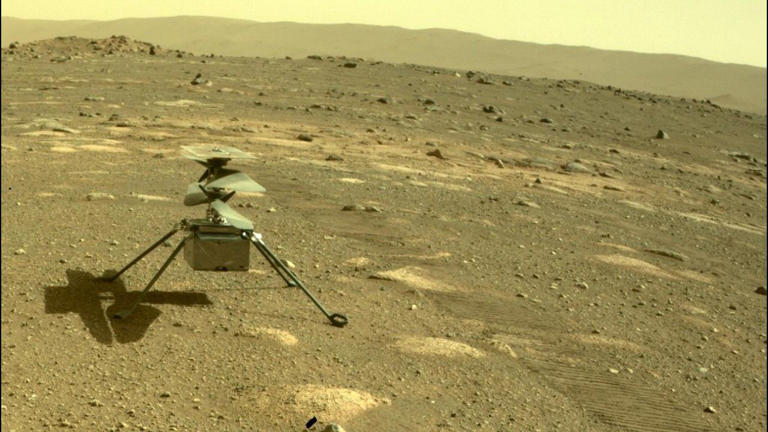Mars Science Helicopter Mission: NASA is set to launch a new advanced helicopter to Mars, building on the incredible success of Ingenuity. This blog explores the details of this exciting venture and its potential for scientific discovery.

© NASA
Mars Science Helicopter Mission
NASA is embarking on an exciting new chapter in its exploration of Mars with the Mars Science Helicopter Mission. Following the remarkable success of the Ingenuity helicopter, which far surpassed its original mission goals, NASA is looking to push the boundaries of aerial exploration on the Red Planet. This mission will leverage valuable lessons learned from Ingenuity’s flights and aim to deploy more advanced technology.
The Legacy of Ingenuity
Ingenuity arrived on Mars in February 2021, attached to the Perseverance rover. Designed for just five experimental flights over 30 days, it quickly became a game changer in planetary exploration. Instead of the planned five flights, Ingenuity completed an astounding 72 flights over nearly three years. This achievement demonstrated that powered, controlled flight is possible in the thin Martian atmosphere, opening the door to future aerial missions.
Ingenuity’s success has set a high bar for the Mars Science Helicopter Mission. By showcasing the potential for aerial exploration, Ingenuity has inspired engineers and scientists to consider how helicopters can be used to gather data and conduct scientific experiments in ways that rovers alone cannot.
Advancements in Technology
NASA’s Jet Propulsion Laboratory (JPL) is now hard at work on the Mars Science Helicopter (MSH) project. The goal is to develop advanced rotorcraft that can carry scientific payloads weighing between 0.5 to 2 kg. This capability could allow for more sophisticated experiments and observations from the air, potentially uncovering new insights about Mars’ geology and its potential for life.
New Rotor Designs
One of the most exciting aspects of the Mars Science Helicopter Mission is the development of new rotor designs. Engineers at JPL have begun testing carbon fiber blades that are almost four inches longer than those used on Ingenuity. These new blades are designed to be stronger and more efficient, enabling the next-generation helicopters to handle a variety of missions more effectively.
The new rotors have already undergone rigorous testing in Earth-based facilities that simulate Martian conditions. They are capable of spinning at near-supersonic speeds of 3,500 rpm—that’s 750 revolutions per minute faster than Ingenuity’s blades! This advancement in rotor technology is a critical step in ensuring that the new helicopters can operate effectively in Mars’ thin atmosphere.
The Mission Ahead
While specific details about the MSH mission are still being finalized, NASA envisions these advanced rotorcraft playing a vital role in scientific exploration and aerial scouting on Mars. The ability to reach areas that are difficult or impossible for ground-based rovers to access could open up exciting new avenues for discovery.
For instance, these helicopters could explore steep cliffs, deep craters, or other challenging terrains that rovers might struggle to navigate. By gathering data from above, scientists could gain a broader understanding of the planet’s landscape, geology, and even its history of water and climate.
Scientific Goals
The primary focus of the Mars Science Helicopter Mission is to enhance our understanding of Mars. With the capability to carry various scientific instruments, the new helicopters could analyze soil samples, capture high-resolution images, and even study the atmosphere. This data will be crucial for understanding the planet’s potential to support life, both past and present.
The mission aims to provide insights that could inform future human exploration as well. By understanding Mars’ geology and climate, scientists can better prepare for potential human missions to the Red Planet, ensuring the safety and success of astronauts who may one day walk on its surface.
Building on Ingenuity’s Success
As NASA continues to refine its designs and mission objectives, the legacy of Ingenuity serves as a solid foundation for this next leap in planetary exploration. The Mars Science Helicopter Mission will build upon the achievements of its predecessor while expanding the possibilities for scientific discovery.
The success of Ingenuity has proven that aerial exploration is not just feasible but incredibly valuable. By continuing to innovate and push the boundaries of what is possible, NASA is setting the stage for a new era of Mars exploration, one that includes advanced aerial capabilities.
Looking to the Future
The future of the Mars Science Helicopter Mission is bright, with exciting possibilities for scientific discovery and exploration. As NASA develops and tests these new rotorcraft, the agency is laying the groundwork for even more ambitious aerial missions on Mars.
With the knowledge gained from Ingenuity, NASA is now focused on creating rotorcraft that can do even more—accessing challenging terrains, conducting detailed scientific experiments, and enhancing our understanding of the Martian environment. As we look ahead, the potential for uncovering new insights about Mars is vast, and the Mars Science Helicopter Mission will play a key role in that journey.
Conclusion
In summary, the Mars Science Helicopter Mission represents a significant step forward in the quest to explore and understand Mars. Building on the incredible achievements of Ingenuity, NASA is preparing to launch a new era of aerial exploration. With advanced technology and ambitious goals, this mission promises to unlock new secrets about the Red Planet and its potential for supporting life.
As we continue to push the boundaries of exploration, the knowledge gained from the Mars Science Helicopter Mission will be invaluable, paving the way for future missions and perhaps one day, human exploration of Mars itself. The journey to uncover the mysteries of the Red Planet is far from over, and the next generation of helicopters is ready to take flight.
Related: